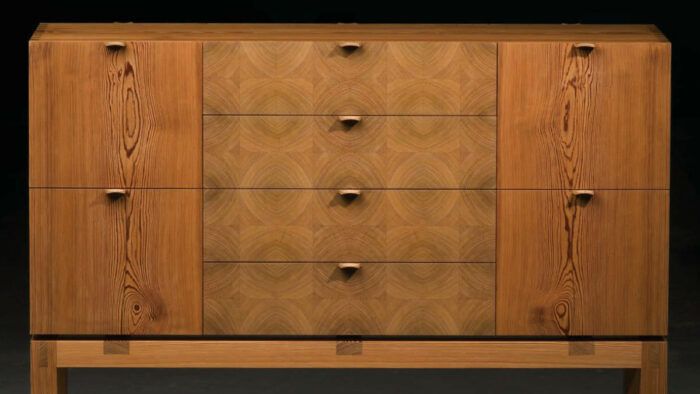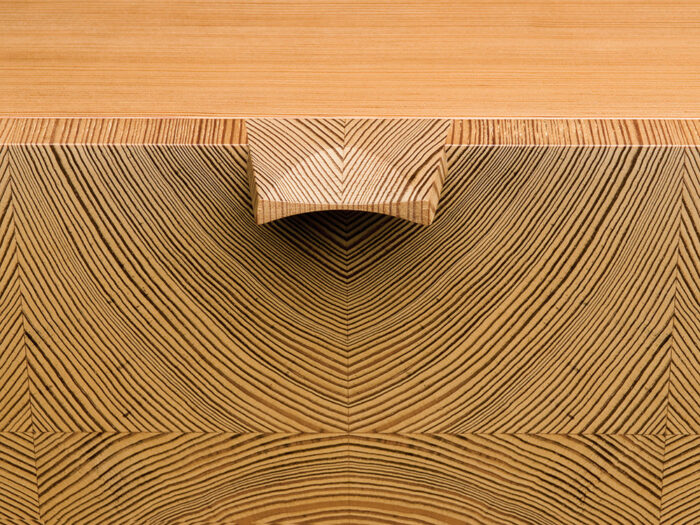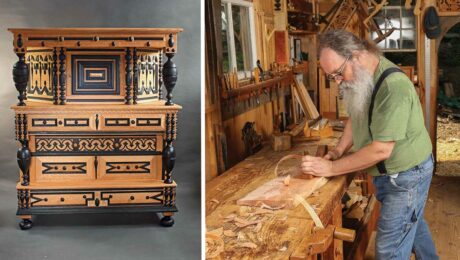Old-Growth Splendor
Wood designed this sideboard with end-grain drawer fronts to highlight the part of the beam that first caught their attention.
 When furniture maker John O’Brien and designer Harold Wood bought “a monster beam” of longleaf yellow pine for $2,500 from a South Texas lumberyard, making the selection “was a crapshoot,” O’Brien said. One in a pile of mammoth timbers salvaged from a dismantled 19th-century South Carolina textile mill, the beam was 25 ft. long, 17 in. wide, and 14 in. thick—500 board feet in a single stick. They could only examine the wood at one end, where a thin slice was cut off to reveal the end grain; the rest was encased in thick layers of old white paint. The beauty of the old-growth end-grain sold them, though, and they had the beam sawn into planks on the spot. Longleaf pine, once coveted for ships’ masts, bridge timbers, and railroad ties, makes a superb furniture wood, and after a “frightening drive” hauling the 25-ft. planks to the shop, O’Brien found working with them a pure pleasure. Later, Wood designed this sideboard with end-grain drawer fronts to highlight the part of the beam that first caught their attention. As the builder, O’Brien was concerned about wood movement, “but we wanted to see how far we could push it.” In fact, by balancing the end-grain visually, Wood and O’Brien seem to have balanced it structurally as well, and over the past year the drawer fronts have remained very stable.
When furniture maker John O’Brien and designer Harold Wood bought “a monster beam” of longleaf yellow pine for $2,500 from a South Texas lumberyard, making the selection “was a crapshoot,” O’Brien said. One in a pile of mammoth timbers salvaged from a dismantled 19th-century South Carolina textile mill, the beam was 25 ft. long, 17 in. wide, and 14 in. thick—500 board feet in a single stick. They could only examine the wood at one end, where a thin slice was cut off to reveal the end grain; the rest was encased in thick layers of old white paint. The beauty of the old-growth end-grain sold them, though, and they had the beam sawn into planks on the spot. Longleaf pine, once coveted for ships’ masts, bridge timbers, and railroad ties, makes a superb furniture wood, and after a “frightening drive” hauling the 25-ft. planks to the shop, O’Brien found working with them a pure pleasure. Later, Wood designed this sideboard with end-grain drawer fronts to highlight the part of the beam that first caught their attention. As the builder, O’Brien was concerned about wood movement, “but we wanted to see how far we could push it.” In fact, by balancing the end-grain visually, Wood and O’Brien seem to have balanced it structurally as well, and over the past year the drawer fronts have remained very stable.
See how O’Brien overcame the technical challenges of working with end grain: How They Did It: End Grain on Display























Log in or create an account to post a comment.
Sign up Log in